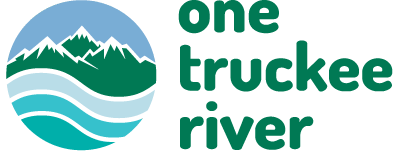10 Reasons to Consider Drip Irrigation
Photo Caption: Lawn sprinklers overspray onto sidewalks. Photo Credit: Carrie Jensen
Water is our most precious and dwindling natural resource. And here in the high desert, we don’t get much of it. Nevada is the nation’s driest state, “with statewide annual average (1895–2020) precipitation only 10.2 inches. Temperatures in Nevada are 2.4 degrees hotter since the early 20th century and rising still, we will see declines in average annual snowpack, directly affecting our freshwater supply.” (NOAA)
Bottom line. . . .being thoughtful about our water usage in our homes and yards is not only a good idea, but becoming more and more necessary. And it’s an important principle of every River-Friendly Yard!
Does this mean I shouldn’t irrigate my yard? Or just landscape with rock?
Not at all. Maintaining a yard is an important part of a home’s ecosystem–yards add habitat for wildlife, provide shade and a cooler microclimate, and–very importantly– they add joy to your life. Dialing in a precise irrigation system for your yard can make all the difference, and save you money by giving your plants just the right amount of water, preventing overwatering and fostering healthier root zones.
That’s why we’re here to talk about drip irrigation.
Here’s 10 reasons we think you should consider drip irrigation for your River-Friendly Yard…..
1. Uses water efficiently
Various studies have documented a savings of 30 to 70%, depending on plant type, climate and use of mulch. That’s a lot of money saved on your water bill!
2. Encourages few weeds
The small moist spot around each emitter, where the water slowly dribbles out, covers only a fraction of the soil’s surface. The larger dry areas between emitters remain too dry for weed seeds to sprout.
3. Saves time
If you have an automated system, it is simply a matter of scheduling it for the right times, and monitoring for leaks, and clogs. No more adjusting sprinkler heads that get kicked or broken by people walking by.
4. Promotes healthy plants
Without the mist produced by overhead sprinklers, drip-irrigated plants are less likely to develop water-stimulated diseases such as powdery mildew, leaf spot, anthracnose, shothole fungus, fire blight and scab, to name a few. Careful placement away from trunks of trees, shrubs, perennials and vegetables will keep the crown of the root system dry and minimize root problems such as root rot and others.
5. Works better on slopes
Sprinklers often create wasteful runoff when watering upper slopes of hills or berms. Drip emitters apply the water slowly enough to allow all the moisture to soak into the soil.
6. Reduces runoff
A well-designed and maintained drip irrigation system should apply water efficiently and have no water running off onto sidewalks and undesired areas. This reduces the potential for pollutants, like pesticides and fertilizers, from washing off your yard, into the storm drain and out to the Truckee River.
7. Promotes better soil structure
Heavy sprinkler irrigation can produce puddles, causing clay particles to stick together, and increase potential for soil compaction. Drip-applied water gradually soaks into the ground, avoiding over-saturation and susceptibility to compaction.
8. Conserves energy
Because of the low-pressure requirements of a drip irrigation system, the pressure requirements and associated pumping costs, whether from municipal water supplies or from your own well, are lower.
9. Uses low flow rates
The low-volume application rate of drip emitters permits larger areas to be watered at the same time than is possible with sprinkler systems.
10. More economical to install
While more costly than a hose with an oscillating or hand-held sprinkler, drip irrigation systems usually cost less than fixed sprinkler systems because they have less trenching and are faster to assemble.
(from Robert Kourik, author of Drip Irrigation for Every Landscape)
Photo Credit: Carrie Jensen
Ok, that’s great information, but what do I do about my lawn?
Typically, overhead sprinklers are used for lawns. Although they provide thorough coverage of the lawn, a considerable amount of the water is often wasted through wind evaporation and overwatering.
There are alternatives to spray. Instead, you can try a subsurface irrigation system like Netafim, which is essentially a flexible irrigation line with in-line emitters. This is something you can install prior to installing your lawn, and because it’s installed below ground, you won’t lose any water to wind, evaporation or runoff. For pre-existing lawns, an overhead sprinkler system can be used, with appropriate irrigation heads and run-times.
Pro tip: If you must use sprinklers, run them in the early morning
Watering in the early morning before the ambient temperatures heat up will help prevent evaporation and keep moisture in the soil. So often you can see lawns being spray-irrigated at high noon when temperatures peak. While it may seem like watering during the hottest part of the day is a good idea, this intense heat causes evaporation, lending to a total waste of precious water resources and your money. Set your landscaping up for success by watering before 10 a.m., allowing that water to soak into the soil and to the root zone before getting wicked away. Also remember to follow Truckee Meadows Water Authority’s (TMWA) assigned sprinkler water days here.
QWEL students conduct a water audit to evaluate a spray irrigation systems efficiency. Photo Credit: Nevada Today
Not sure where to start?
Find a Qualified Water Efficient Landscape professional, or sign up for free TMWA irrigation workshops. Either by hiring a professional or educating yourself, you can conserve water with an efficient irrigation system while also protecting the Truckee River from pollutants that runoff from sprinklers. Now that’s River-Friendly Living!
Resources and Further Reading
NOAA, NOAA State Summaries
Kourik, Robert. Drip Irrigation for Every Landscape. Robert Kourik's main website
USGS,Water Science School



